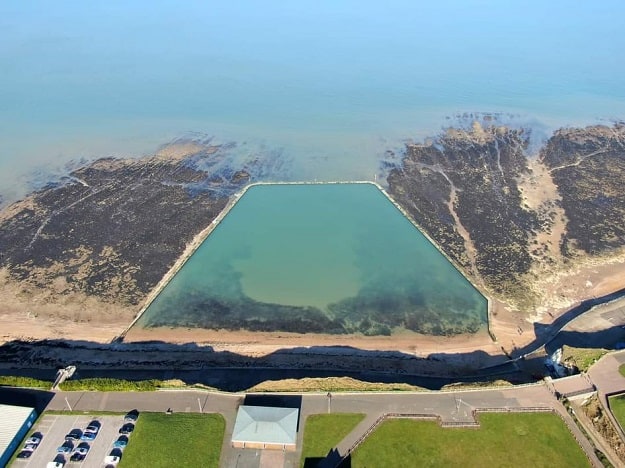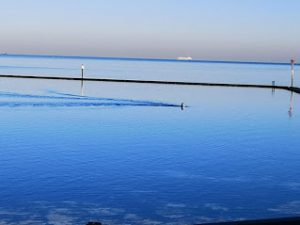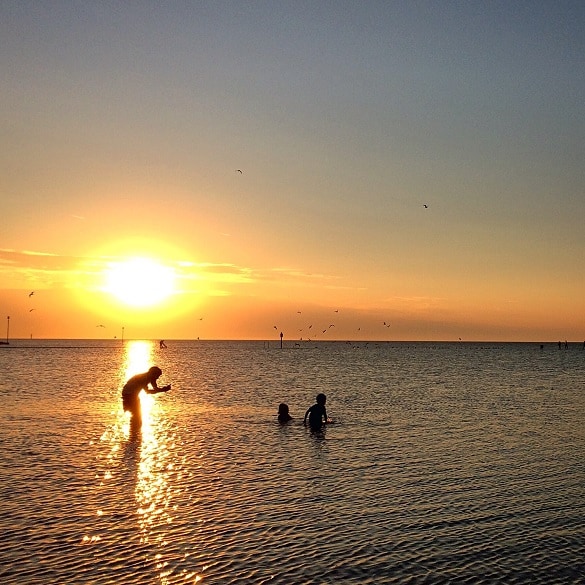
A spike in E.coli levels has been recorded at Walpole Bay, prompting a Margate ward councillor to question how safe it is for swimming.
The reading, taken just under a week ago, recorded the highest levels of colony forming units of Escherichia coli and Intestinal Enterococci in several years. The readings taken on July 14 exceed the limit for “sufficient” water quality under the Bathing Water Directive. Other Margate bathing waters are unaffected.
Margate councillor Rob Yates, who is a keen outdoor swimmer, says he is concerned over the lack of information about whether it is safe to enter the water at Walpole Bay with the current E.coli presence.
An Environment Agency spokesperson said: “Occasional poorer quality bathing water sample results do occur even at our cleanest bathing waters. This can often occur following periods of heavy rainfall washing contaminants from surrounding land and urban areas into the sea and the E-Coli can come from a number of sources including sewage, and animal faeces found naturally.
“The overall quality of a bathing water is therefore based upon multiple samples taken over a four year period to give a better long term assessment of water quality.
“The bathing water at Walpole Bay is currently classified as good and will continue to be sampled weekly throughout the bathing water season.”
The Environment Agency says samples will continue to be taken weekly.

Cllr Yates said: “The good news is that the Environment Agency has confirmed it will continue to do weekly sampling at Walpole Bay so we will soon see if this is a short or longer term issue.
“Given the lack of transparency from the EA or the council about whether the latest sample is safe for swimming I am informing people to avoid swimming at Walpole Bay until the samples improve. I love outdoor swimming, but until someone can tell me that those levels are safe, then swim at Westbrook or Margate Main Sands.
“The public has a right to know whether a location is suitable for swimming in. Currently we have two situations where the public are not being informed whether the water is safe. The first is following waste-water release, where screened drainage water from roads and households are emptied into the sea at Foreness Point, currently Southern Water recommends not swimming for 24 hours following this, but TDC and the Environment Agency are silent.

“The second situation is where water tests uncover higher rates of E-coli than normal, such as were found at Walpole Bay on Wednesday 14th July – surely someone must know whether 500 colonies per 100ml is safe for swimming or not? If someone does know, please email me. I absolutely love swimming at Walpole Bay and will be back there as soon as the sample results return to normal, in the meantime I will continue to press the EA and council to provide adequate information to residents.
“Currently if you are in doubt, you will need to check both the Southern Water beachbuoy website about releases, and you will need to check the Environment Agency’s Bathing water quality website and make up your own mind based on the findings.”
The Environment Agency says there have been no reports of discharges in the area from Southern Water.

The agency says: “Anyone can become unwell when swimming in open waters. To help reduce the risk of becoming ill, Public Health England and the Environment Agency offer advice in their ‘swim healthy’ guidance which is available to read before making any decision on swimming.
“If there are any safety concerns, please contact Public Health England or Thanet District Council.”
A Thanet council spokesperson said: “Walpole Bay Tidal Pool is an intertidal structure which means that the sea water doesn’t stay in the pool. The sea covers the pool on every high tide and the structure retains some of the tidal water on the ebbing tide.
“The reading in question was taken on July 14 after heavy rain on July 10 and 12. The Cliftonville bays often show higher readings after a rainfall due to the nature of the roads and slopes running directly into the sea. Rain water collects dog faeces and other matter as it travels down the slopes into the sea.”
The E-coli reading will be disappointing news for Walpole Bay swimmers as there had been a lengthy wait to achieve a good water quality rating at the site.

A Seaside Award at Walpole Bay was granted in 2019. Prior to that the Bay had been rated as poor under EU water quality regulations for several years. In the ratings for 2016, under stricter EU regulations which came into force in 2015, Walpole Bay received a poor standard despite having 17 ‘acceptable’ water quality results out of 20 weekly samples. In 2018 year it was graded as sufficient rising to good the following year, a status it currently retains.
When a temporary reduction in water quality is forecast, due to factors, such as heavy rainfall, wind or the tide, a pollution risk warning and advice against bathing is issued. Warnings are posted at https://environment.data.gov.uk/bwq/profiles/) and https://www.southernwater.co.uk/water-for-life/our-bathing-waters/beachbuoy
It takes several days to analyse and receive a single bathing water sample result as the microbial sample needs to be incubated and cultured.
Designated Bathing Water Testing – Definition by the Environment Agency
The Environment Agency takes up to twenty water samples at each of England’s designated bathing waters during the bathing water season between May and September each year. A classification for each bathing water is calculated annually based on samples from the previous four years. These classifications are, from best to worst:
Excellent – the highest, cleanest seas
Good – generally good water quality
Sufficient – the water meets minimum standards
Poor – the water has not met the new minimum standards. If water is classified as poor, then a sign advising against bathing will be displayed. However the beach remains open for people to enjoy.

